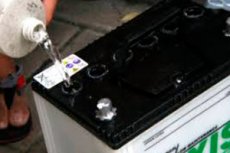New publications
Electrolyte vapor poisoning
Last reviewed: 29.06.2025

All iLive content is medically reviewed or fact checked to ensure as much factual accuracy as possible.
We have strict sourcing guidelines and only link to reputable media sites, academic research institutions and, whenever possible, medically peer reviewed studies. Note that the numbers in parentheses ([1], [2], etc.) are clickable links to these studies.
If you feel that any of our content is inaccurate, out-of-date, or otherwise questionable, please select it and press Ctrl + Enter.

Today there are many different batteries and accumulators, but the most common are those that contain electrolytes (a substance that conducts electric current). The most common conductor is sulfuric acid.
Inhalation of electrolyte vapors and ingestion of the substance can cause damage to the body. Sulfuric acid vapors are contained in lead batteries. When exposed to them, irritation/chemical burns of the eyes and mucous membranes, larynx, pharynx occur.
Symptoms of the electrolyte vapor poisoning
Symptoms of intoxication:
- Sore and scratchy throat.
- Skin hyperemia.
- Spasm of the vocal cleft.
- Throat swelling.
- Bronchial spasms and asphyxia.
- Nosebleeds.
- Chemical burns of varying degrees of severity.
If the electrolyte vapors affect the skin, it leads to the development of chemical burns. Tissues become red and swollen, blisters appear with accumulation of scab, which collects as a crust at the place of contact with alkali.
The most dangerous is the entry of alkalis into the middle of the body through the digestive tract. If somehow a person has taken electrolyte inside, then instantly there are sharp sharp pains in the mouth and pharynx, along the course of the esophagus, stomach. GI bleeding develops, which is very difficult to stop. The victim has increased salivation (salivation), which is dangerous asphyxia.
Treatment of the electrolyte vapor poisoning
First aid in case of vapor damage consists in removing the victim from the contaminated area. To rinse the mouth prepare a 2% solution of soda or furacilin (1:5000), it is also recommended to drink milk or mineral alkaline water. This will reduce the concentration of the electrolyte acid and bind some of its molecules.
If the substance has been ingested, an ambulance should be called immediately. Before the ambulance arrives, rinse the stomach with plenty of water. To neutralize the alkali take acid solutions (acetic, citric acid) or cow's milk. In hospital conditions, the patient is given complex therapy. Lack of treatment is dangerous for gastric perforation and even death.
